Closing the Loop
This story originally appeared in the October/November 2020 issue of Adventure Cyclist magazine.
As I neared the top of Chilkat Pass, everything vanished — swallowed by a dense fog. When I looked behind me, my partner rode into view like an apparition. The wolf tracks alongside the road appeared very real though, so I slowed my pace to drift closer to my fellow human.
I’d never done anything like this. Before this ride, I could tentatively call myself a bike commuter, but even that had been a while ago. I’d spent the past couple of months working on a fishing boat in western Alaska, pulling sockeye salmon out of a net, and all of my movements had been confined to the 32 feet between the bow and the stern.
Pedaling up a mountain into the Yukon with shaky sea legs, getting totally soaked, and edging toward hypothermia definitely felt adventurous. Also a little dumb. I regretted not putting on my rain gear when we first started riding into this chilling mist, but I took some abstract comfort in the fact that this particular intersection of Alaska and Canada has a rich history of luring in foolhardy adventurers.
The 350-mile route we rode is called the Golden Circle, named for the historic Klondike Gold Rush that exploded in this region in the late nineteenth century. This frantic migration of 100,000 would-be miners to the north was so epic in proportion and fatal in consequence that it was called a stampede. The stories of hardship and heartbreak experienced by the stampeders as they attempted to strike it rich in a hostile environment were made legendary by authors like Jack London and Robert Service. The Golden Circle travels the very routes used by those fortune-seeking prospectors.
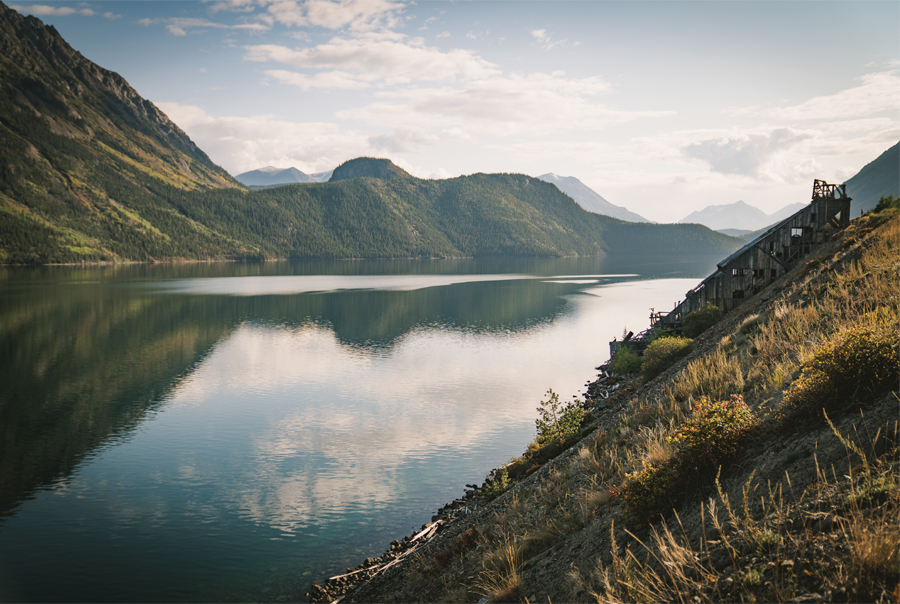
We began riding in Haines, Alaska, a tiny town at the end of the longest, deepest fjord in North America. We then followed the Chilkat River through Klukwan, a Tlingit village that has been on the river’s banks for hundreds of years. From there, we climbed through the Chilkat Pass, traveling along a traditional trade route of the Tlingit and Athabascan peoples. Most of our ride was on rolling plateau on a route that wound through Whitehorse, the capital of the Yukon, and then back through another mountain pass to Alaska and the iconic gold rush town of Skagway. To close the circle, it’s necessary to hop on a ferry and sail back to Haines or down to Juneau.
Ferries are what make this ride possible as a loop, and in the summer they run regularly between Haines and Skagway. Arguably, the Golden Circle can be started in either town. A sound reason to start in Haines is the mellower grade of the climb into the Yukon, but we also had personal reasons for beginning there.
I moved to Haines in the dead of winter a few years ago. I’d come to fight against a modern-day gold rush, one that bore little resemblance to the romanticized individualism of 1898. Today, multinational mining companies are scrambling for investors and permits to dig for copper and gold in the mountains above the Chilkat River, one of the most important salmon-producing rivers in the region. These fish have been sustaining the Tlingit people for thousands of years, and within the last century the salmon have become essential to commercial fisheries as well. Mines and fish don’t mix: the pollutants unearthed by mining can have a negative impact on salmon in perpetuity.
Even though I moved to Haines from a nearby community and my family has long been harvesting salmon spawned in the Chilkat River, when I first showed up in town I was immediately labeled by some of the residents as an “outside environmentalist.” I had moved to Haines to serve as executive director of a local conservation organization, and as I navigated this job — a heady mix of heated public meetings and long hours alone in a dark office at the end of a dirt road — a few major things happened totally by accident.
First off, I fell in love with Haines and its endearing assortment of contrarians, fishermen, artists, and ski bums. Second, I met my boyfriend, who was working on a documentary film about the threat of mining in the Chilkat Watershed. Finally, I crashed my trusty garage-sale bike on a patch of ice and replaced it with the sleekest ride I’d ever owned: a Surly Disc Trucker from the local bike shop.
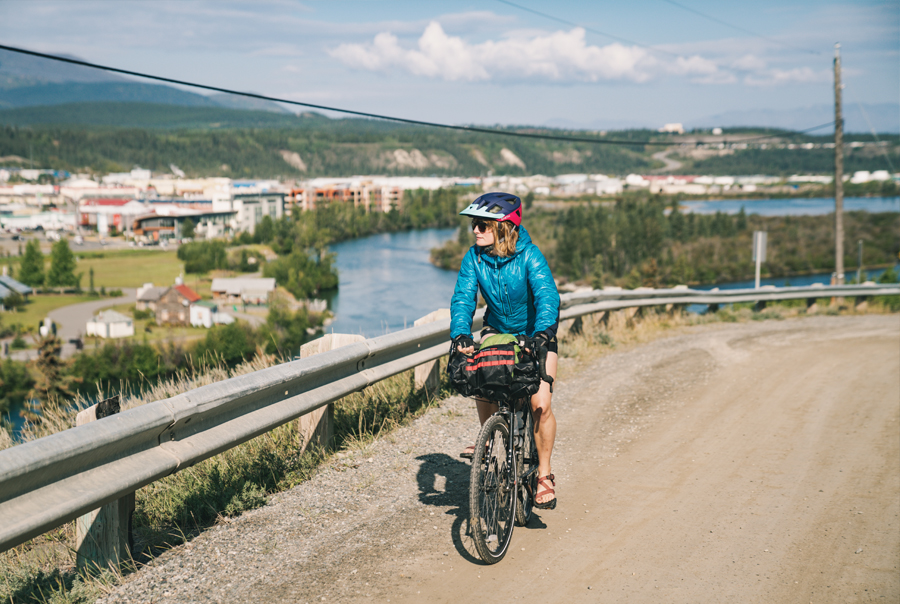
When I left that job, I still had the bike, boyfriend, and love for the town. Less cheerfully, I still saw the local rivers, mountains, and forests through the lens of political controversy and potential loss. We had many reasons for wanting to ride the Golden Circle — my first bikepacking adventure — but, deep down, I was hoping that I could pedal my way into a richer, less fraught relationship with this place.
After we made it over Chilkat Pass and began our descent into the valley beyond, the fog turned to rain. It felt like riding into a cresting wave, but even as my hands cramped with cold I was still awed by the scenery that rose into view as we lost elevation. A lake wrapped sinuously around the base of the mountains, and even under gray skies it sparkled a bright turquoise.
Our destination on that first night was known simply as the Green Shack. It’s a refuge for cold and wet folks like us, and it’s regularly stocked with firewood by the Canadian Park Service. In the summer, the Green Shack is visited by motorcyclists and bikepackers; in the winter, it’s skiers and snowmobilers. Once we arrived, I shucked my wet layers, crawled into my sleeping bag, and gratefully drank some of the bottle of wine that we’d cached days before. As I warmed up, I flipped through the visitor log and studied the quotations and crayon graffiti scrawled across the wall. From the stories they told, I started to understand that the Green Shack was much more than a shelter — it’s a gentle reprimand to those entering this mighty land without proper caution. Without this little cabin, I would’ve been dangerously cold, struggling to set up a tent with numb fingers.
The following morning, we slept until the rain stopped tapping the roof, and we emerged from the Green Shack to a gleaming valley. As we filled up our water bottles from swollen creeks, I could see that the tiny plants of the tundra were starting to burn red and gold with the changing season. Seed pods spiraled elegantly across the road’s shoulders.
Besides the occasional lumbering RV, the roads here seemed to be the nearly exclusive domain of motorcycles and bicycles. While the RVs seemed as foreign as spaceships in this wild country, the motorcyclists felt like our compatriots in adventure. As we were pushing up a particularly arduous hill, legs burning, a solo biker came roaring down from above with the speakers on his handlebars blasting Brazilian jazz. The funky horns seemed to be a jubilant tribute to the beauty that was all around us.
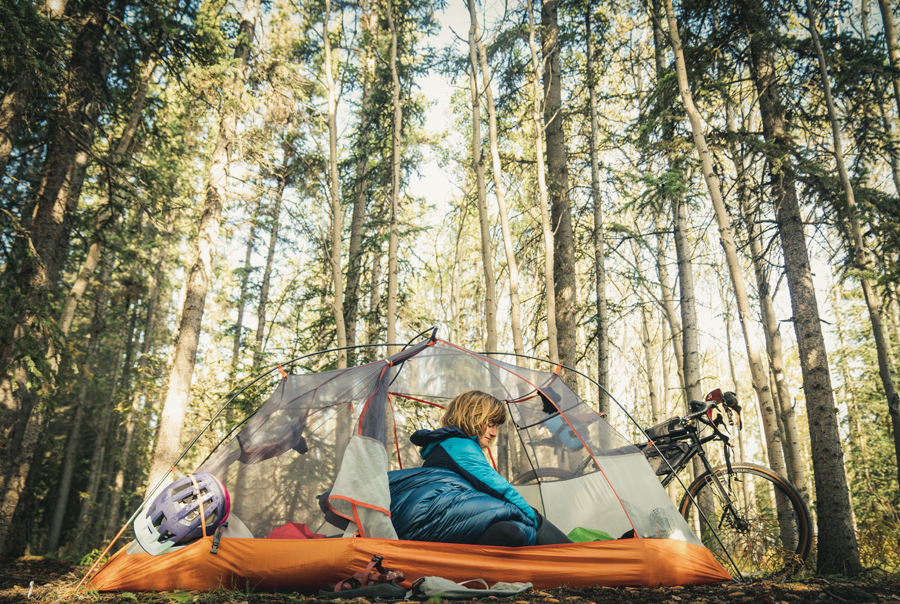
After a day of pedaling through majestic mountain valleys, we spent our second night in a campground by Dezadeash Lake. We dried our clothes over a fire in the cooking shelter, and by the time the rain started to fall again, we had stretched out in our sleeping bags.
In Haines Junction, we made a much anticipated stop at the famous Village Bakery, one of the few businesses in this tiny crossroads town. After eating a wide selection of baked goods and savory treats, I started to work my way through coffee refills as I listened to locals discussing the upcoming salmon bake, hosted every Friday by the Village Bakery and featuring live music, beer, and dancing.
Turns out that in a place like Haines Junction, bread is just one of many things the bakery cooks up.
I’m used to small-town Alaska, but there was something special about traveling in a wild place like the Yukon that made it easier to appreciate the way people are shaped by epic landscapes and plenty of elbow room. More often than not, the indigenous people — and those who have recently found a home in these wild places — are deeply generous. Whether it’s expressed through continually restocking firewood at the Green Shack or sharing local knowledge with travelers, this generosity can mean a lot to those at the mercy of the wide-open spaces and the ever-changing weather.
The next day’s ride heading toward Whitehorse felt long. It’s flat country, and even though there were occasional surprises, like watching coyotes hunt along the road, the taiga forest was less scenic than the dramatic mountain valleys we’d been riding through, and the traffic was steady. We made it 50 miles, halfway to Whitehorse, and began looking for a place to camp. Roadside camping options were less than ideal, and as it grew dark we were coming to terms with what looked to be an uncomfortable night.
When we saw the handmade highway sign for Irene’s Restaurant and Bar, we were skeptical that a business could even exist in a place this remote. But Irene’s is an oasis in the Yukon, a one-woman show with local beer served in frosty glasses and seriously tasty home-cooked lasagna. When I shyly asked about camping options, Bella, our host, happily waved us to the grove of trees behind her restaurant. We slept soundly despite the frequent howling of nearby wolves with accompanying vocals from neighborhood dogs.
We reached Whitehorse the following day and enjoyed a night out on the town in what felt like a surprisingly cosmopolitan little city (Whitehorse’s 25,000 residents represent 70 percent of the population of the Yukon Territory). We ambled down the clean streets in our bike shorts and found a hip bar that served us cocktails and wood-fired pizza.
We got a late start out of Whitehorse, and we were still 15 miles from our campground when the sun started making long shadows through the black spruce. We tried to be extra cautious of vehicles as the darkness closed in, and when a car pulled over we expected a reprimand for riding in low light. Instead we received a warning about a bear family ahead of us. A mama brown bear on one side of the road, her two playful cubs on the other.
We fell silent, trying to figure out how we could possibly crest a hill between a protective mama and her cubs. Before we could come up with a plan, another car with two lanky bearded Canadian guys pulled over and offered to shuttle us past the mama bear. We thanked them profusely, and one of them told us his own story of getting a shuttle past an aggressive bear when he was cycling in Alaska. He was happy to do a good turn.
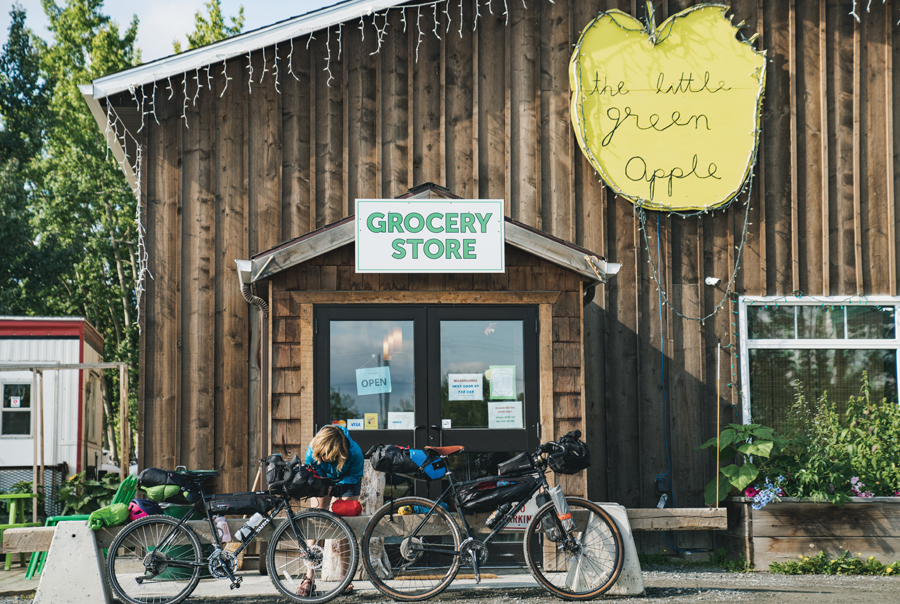
The next morning, we awoke to sunshine and pedaled into the town of Carcross for breakfast. Carcross (pop. 300) is home to the Tagish First Nations people. It’s an incredibly beautiful community with smooth white roads along the banks of a deep blue lake, sweeping mountains, and a newly constructed cultural center showcasing outstanding indigenous art.
Although these lands have been the home of the Tagish and Tlingit indigenous people for thousands of years, Carcross was only permanently established during the Klondike Gold Rush. Since then, the Yukon’s economy has been primarily dependent on resource extraction, and Carcross was no exception.
Twenty years ago, the Tagish people started working toward self-governance. At the beginning of the process, the community identified a primary concern: Tagish youth were losing their connection to the land and leaving the village in droves. When Carcross fully transitioned to self-government in 2006, they had an ambitious plan to establish their community as a tourism destination, but they wanted to do it in a way that would revitalize local connections to the land.
In the last 15 years, Carcross has built a world-class collection of mountain bike trails, shredded annually by an estimated 2,500 riders. At the heart of this effort is the Singletrack to Success program, which employs local First Nations youth to build and repair the trails. Carcross made a decision to shift their economy to tourism without forgetting to incorporate their values into their vision. By many accounts, when they made that decision, it felt risky. It’s a lot easier for rural communities to accept jobs as they come, through boom-and-bust extractive economies, than to make a long-term plan for a sustainable future.
We vowed to return with our mountain bikes to ride these epic trails, but on this journey we didn’t do much more in Carcross than drink a cup of coffee, enjoy the views, and chat with some stoked mountain bikers. I later found out that a Whitehorse-based bike shop has a mini mountain bike rental in Carcross — this might be my one regret from this ride.
On our final day, we woke before the frost had melted from our tent and set out early so as to catch our ferry from Skagway. We stopped at the top of the mountain pass and leaned our bikes against the Welcome to Alaska sign. As we dug through our seatbags for dried fruit, two huge buses trundled up the mountain and ground to a halt next to us. We watched in bemusement as the quiet landscape turned rowdy with tourists fresh off one of the massive cruise ships docked in Skagway. Some of the cruise ship’s passengers expressed joyous wonderment, others seemed bored. Everyone took pictures. As the tourists lined up to pose for photos by the Alaska sign, one of their guides requested that we find somewhere else to lean our bikes. Finishing our last mouthful of crackers suddenly felt like a small act of protest.
We quickly forgot the absurdity of this encounter as we descended from 3,800 feet to sea level in just 15 miles. Our disc brakes were literally smoking as we sped through the lush, craggy, wild pass. Along the road there were pull-outs with interpretive information about the Klondike Gold Rush. The grisly facts painted a stark picture of what men will do for the promise of riches: 3,000 pack horses died on Dead Horse Trail; smallpox devastated indigenous communities; and in the end, only a few made fortunes while many others lost everything in the attempt.
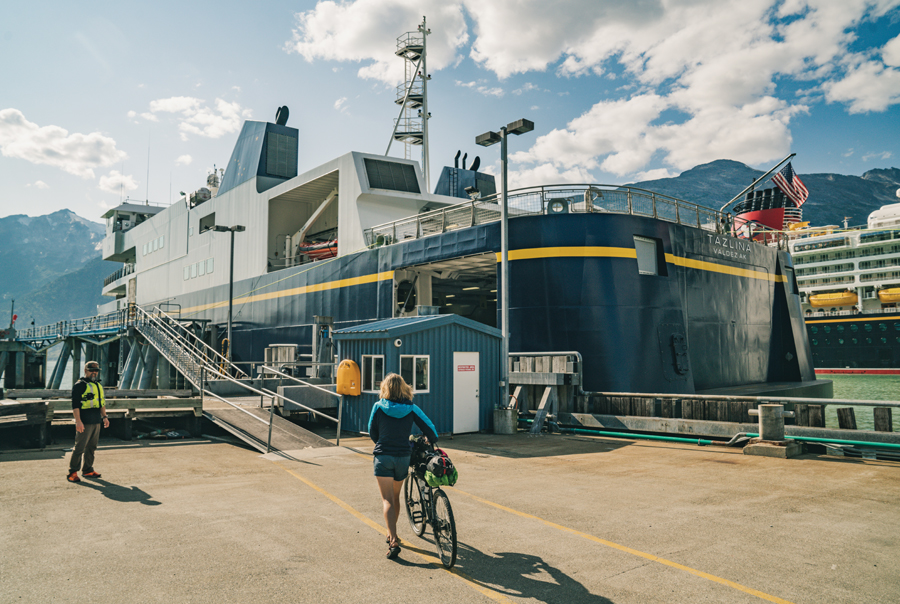
Our time in Skagway was brief, just long enough for an ice cream cone and some people-watching before we boarded our ferry, which looked like a toy docked next to the massive cruise ship. I’m told that our ferry ride back to Haines was nice, but I missed it. I was sleeping on the sundeck.
I found what I had been looking for on this ride: a deeper connection to the land separate from the political battles over its future. But I also received the welcome I didn’t know I was looking for. People are an extension of the places they live, and small-town politics has a way of obscuring this bigger truth. Throughout this ride, there was something special about how kind locals were to us. It felt like people appreciated not only the fact that we were visiting, but the way we were doing it. In turn, we were impressed by the spirit of these communities and for the way that some rural communities are reclaiming their future by resisting cycles of boom and bust and developing businesses and an economy in a way that benefits both people and the land.
Back in Haines, our first stop was for a celebratory drink at the Port Chilkoot Distillery, but we also dropped by Sockeye Cycle, where I had purchased my Surly a few years ago. The business had just changed hands, and the new owners were wrapping up their first tourist season, exhausted and happy after showing so many people this wild land. We shared a report of our ride and chatted about the bike tourism we’d seen in Carcross, and how tourism can bring stability to rural towns.
That was back in the fall of 2019, and as I wrote this article in the spring of 2020, it was hard not to think about how COVID-19, and the dramatic decrease in visitors, will make it hard for many small tourism businesses to hang on. Without locally owned businesses, the economies of rural communities in Alaska and the Yukon are defined by what big multinational companies bring to the table: mining, resource extraction, short-term profit, and long-term social and environmental consequences.
Tourism has been mostly a good thing for rural towns in the north, and everywhere we went on the Golden Circle we found businesses committed to doing tourism the right way. As we look forward to our next adventures, we should remember that COVID-19 has hit rural economies especially hard. Hopefully we can soon re-enter rural communities like those we explored on the Golden Circle, but for now we can think ahead about how to show these rural places the generosity of spirit that they are so quick to show us.
The outdoor community has hit a moment of reckoning with COVID-19. For many of us, it’s meant exploring closer to home and tabling our larger travel plans. But it should also make us more aware of our impact on places wherever we go. As bike travelers, we’re more than self-powered specks on the landscape. We’re part of the picture.

